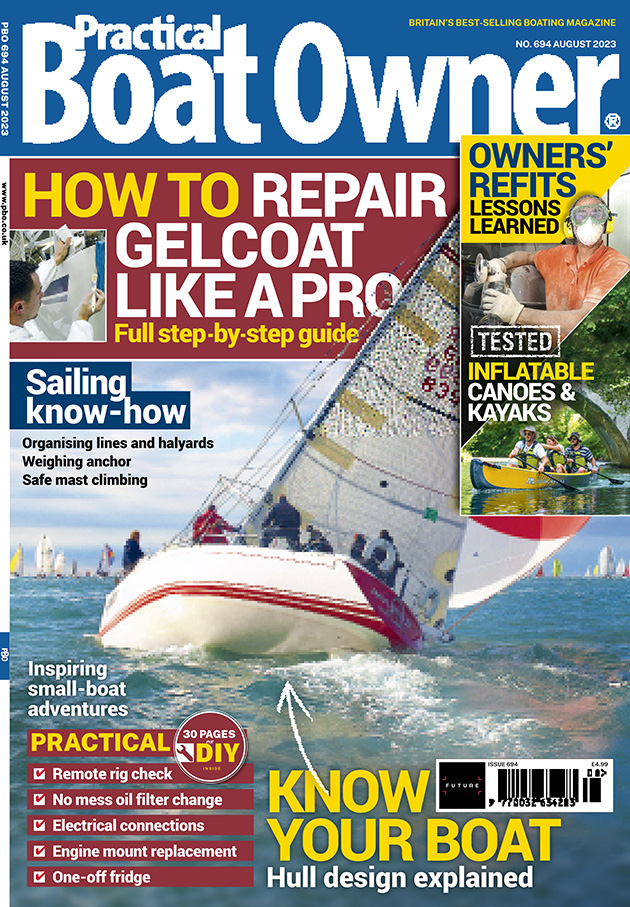Rupert Holmes explains how electric bilge pumps work and why performance doesn't always meet expectations
Best bilge pumps: electric pumps, emergency pumps and alarms
We all know that effective bilge pumping arrangements are essential for safety at sea, yet a surprising number of boats are lacking in this respect.
Automatic electric pumps often sound like the ideal solution, but many installations fail to live up to expectations. One of the reasons is that real-life installations are often much less powerful than the pump’s specifications on paper might suggest.
Buy a bilge pump
- 500 GPH Pump, Rule-A-Matic Float Switch
- SAILFLO Bilge Pump Automatic 12v
- Osculati Rule Mate automatic bilge pump 55l/min 12 V
- Shurflo 700 bilge pump – 12 VDC, 700 GPH
Buy a high capacity bilge pump
Note: We may earn a commission when you buy through links on our site, at no extra cost to you. This doesn’t affect our editorial independence.
A key issue here is that rated performance is often given at the pump outlet, not where the water exits the hull of the boat. If bilge water has to be lifted 3ft to get it out of the boat the flow rate will be reduced by 30%.
Equally friction in the pipework – especially where reinforced corrugated pipe is used – can account for a further 20-30% reduction. In addition, flow rates are often quoted for 13.5V of power reaching the pump, but that’s only likely to happen with the engine running. If the service batteries are half-discharged at around 12.2V there will be a further reduction in flow.
When these three factors are added together it’s not unusual to see real-life pump outputs of only 40% of the rated figure, even for good installations.
If there are long pipe runs with lots of elbows, or undersized/corroded wiring to the pump, output may not even reach 25% of the rated flow. And if the pump rating is for US (rather than imperial) gallons then flow rates will be even lower than owners on this side of the Atlantic might expect.
A second problem with standard leisure automatic pumps is that there’s no warning until something has gone badly wrong. In times gone by we would count the number of strokes needed to empty the bilge with a manual pump at the change of each watch. Any developing problem would therefore come to light at an early stage.
However, if an electric pump deals with small ingresses of water without fuss you don’t have advance notice of a developing problem until the pump can no longer keep up with the ingress, or the vessel’s batteries run flat. By contrast, many commercial fishing vessels have been saved thanks to their mandatory bilge alarms.
Bilge water alarms
In many yachts it’s a straightforward enough job to fit an alarm. An existing set-up could be adapted, for instance, by wiring a low-cost buzzer to the float switch so that the alarm sounds when the pump operates. However, a separate alarm system is a better option, as this will function even if the pump’s float switch fails.
There are also cost-effective options for sensors, starting at £120, that will automatically ping a message to your mobile phone or email when the alarm is activated. Examples of remote monitoring sensors include Blueguard, Chargemetrix and Yacht Sentinel.
Buy a bilge alarm
- Rule 33ALA Marine High Water Bilge Alarm (Mercury Free, 12-Volt)
- Wi-Fi water Level/sump monitor Sensor with buzzer, email/text Alerts
Some more handy articles on bilges

We looked at eight options for cleaning bilges, from dedicated products to household cleaners
- What’s the best bilge cleaner for your boat? See PBO’s test of best bilge cleaners
- How to make your own bilge water alarm
- Bilge sensor clogging up with gunk?
Emergency pumps
It’s also important to remember that bilge pumps are only really intended as a convenience for emptying incidental water ingress, not for emergency situations. That’s why World Sailing has introduced a requirement for longer offshore races, plus cruising events such as the ARC, to carry a high-capacity emergency pump.
This needs to have a minimum rated capacity of 200lt per minute (ie 3,160 US or 2,650 imperial gallons per hour) and can be either portable or permanently installed. Products such as Rule’s 3700 and Rule’s 4000 models, and the largest of Whale’s Orca 3000 satisfy this requirement. Prices typically start from around £165.
For more advice on buying a bilge pump, ASAP Supplies is very helpful.
Enjoyed reading Best bilge pumps: electric pumps, emergency pumps and alarms? 
A subscription to Practical Boat Owner magazine costs around 40% less than the cover price.
Print and digital editions are available through Magazines Direct – where you can also find the latest deals.
PBO is packed with information to help you get the most from boat ownership – whether sail or power.
-
-
-
- Take your DIY skills to the next level with trusted advice on boat maintenance and repairs
- Impartial in-depth gear reviews
- Practical cruising tips for making the most of your time afloat
-
-





